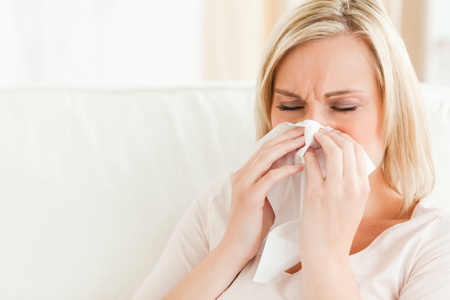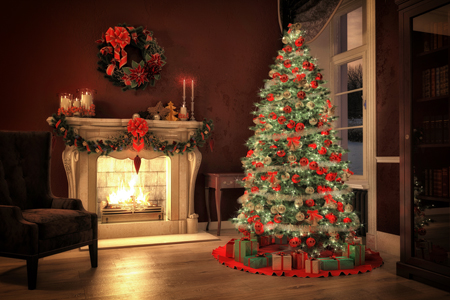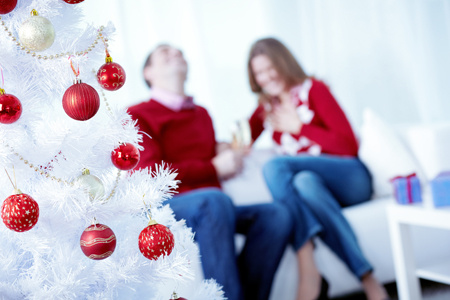Why Your Christmas Tree Could Be Making You Ill!
A newspaper article was published to explain the potential health concerns caused by your Christmas tree: “How CHRISTMAS TREES can cause hay fever hell: Pollen grains, dust and mould can trigger sneezing, coughing and a runny nose”
The article dubbed the illness, Christmas Tree Syndrome, because 1 in 3 (approximately 35 percent) people get sick, suffering from hay fever like symptoms, soon after the Christmas tree is set up in the home.
This article explains what causes Christmas Tree Syndrome and provides recommendations on how you can minimize the potential health issues caused by this indoor air quality issue.
Health Symptoms of Christmas Tree Syndrome!
Typical signs that your tree is making you ill include the following:
- Asthma attacks, usually triggered by cladosporium mold
- Rhinitis
- Runny nose
- Sinus pain
- Sneezing
- Wheezing
- Coughing
- Cold like symptoms, that subside when away from the home or the room with the tree in it.
Mold Is The Cause Of Christmas Tree Syndrome!
Prior to the studies documented below, it was thought that tree pollen or even weed killer applied to Christmas trees made people ill.
However, as the studies below conclude, the core cause of Christmas Tree Syndrome is mold, which releases spores and causes allergic reactions:
“Researchers at St. Vincent’s Medical Center in Bridgeport, Connecticut, found that a room containing a fresh Christmas tree for two weeks had mold levels that were five times the normal level. Other studies have shown that levels this high can cause allergic rhinitis and asthma symptoms, says the study’s coauthor, allergist and immunologist Philip Hemmers.” (A fresh Christmas tree for two weeks had mold levels that were five times the normal level)
In another study Dr. John Santilli, compared the level of mold spores in the home before and after the tree was placed in the home. The normal level of mold spores is 800 per cubic meter, but within 14 days of the Christmas tree being in the home, the level of mold spores increased to 5,000 spores per cubic meter.
Another scientific study by allergy specialist, Dr. Lawrence Kurlandsky at Upstate Medical University in New York set out to determine why respiratory illnesses peak around Christmas. The study found 53 different kinds of mold, including, aspergillus, penicillium, cladosporium and alternaria, which can trigger asthma attacks, sneezing and a runny nose. One of the key conclusions made by this study was 70 percent of the molds found triggered allergies and asthma.
Minimizing Mold From Your Christmas Tree!
Mold spores are found naturally on Christmas trees, which will flourish once they are in a centrally heated home.
With this in mind, if you can manage Christmas with an artificial tree, that is the best solution. Please note, artificial trees can accumulate a layer of dust and even mold if not stored properly. Be sure to store your artificial tree in a dry area and preferably in plastic tubs to minimize exposure to moisture and dust.
However, if you must use a live Christmas tree, here are some tips to minimize the health impact:
- Thoroughly hose down your tree and let it dry before bringing it into the house. If you bought your tree at a nursery, ask if they have tree washing services.
- Clean all ornaments and lights before putting on the tree; they can harbor dust and molds. Store all decorations in plastic containers that can be easily wiped down since cardboard can potentially attract dust and mold.
- Minimize exposure. If you’re sensitive to molds, keep a live Christmas tree no more than four to seven days.
- Run an air purifier in the same room as the Christmas tree. This may help alleviate symptoms.
- Allergy medication may also help alleviate some symptoms as well.
- Since mold spores may accumulate the longer your tree is in the house, consider getting rid of it first thing on the 26th.
Got Mold Questions?
Happy holidays from your friends at Mold B Gone. If you have questions, we are here to help! If you think you have mold, call us, 678-697-6267 or contact us via e-mail for further assistance.

The team at Mold B Gone wishes you a safe and happy holidays! We look forward to serving you in 2018! 🙂
Live Xmas Trees Can Trigger #Mold Allergies https://t.co/AbFqxUVDDT PLEASE RETWEET pic.twitter.com/t3zmDdfuyy
— Mold B Gone (@moldbgonega) December 15, 2017





